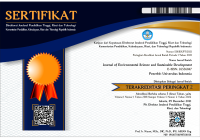Abstract
Tofu is a soy-based food that is frequently consumed by Indonesian as a protein source. It is usually produced by household industries using traditional technology, which currently experiencing environmental problems with respect to the inefficiency of resource usage and inadequate waste disposal. Therefore, cleaner production strategy is potential to be implemented by previously mapping the current problems faced by the industries. This study aims to present an environmental analysis on tofu production in Salatiga in the context of cleaner production. In addition to provides information about the current production process and explains waste management performed by the industries, this study describes how the people in Kalitaman-Salatiga consider environmental issue around the tofu production. This study was conducted by a qualitative approach using interview, observation, and documentation. Laboratory analysis was conducted to provide supporting data. The results showed that only a small proportion of the tofu production process in Kalitaman meets the indicators for cleaner production in term of using raw materials efficiently and reusing solid wastes. Wastes in the form of smoke and wastewater are still disposed without prior treatment. The BOD5, COD, and TSS contents of tofu wastewater exceed the quality standard set by the Indonesian government. Although the respondents understand the negative impact of pollution to ecosystem, they are not yet concerned because it does not show a direct detrimental impact on their community. Therefore, raising environmental awareness is required in order to protect the ecosystem and to prevent environmental deterioration.
Recommended Citation
Nugroho, Gefa Satria Fajar; Sulistyaningrum, Ravika; Melania, Reindra Prastiwa; and Handayani, Widhi
(2019).
ENVIRONMENTAL ANALYSIS OF TOFU PRODUCTION IN THE CONTEXT OF CLEANER PRODUCTION: CASE STUDY OF TOFU HOUSEHOLD INDUSTRIES IN SALATIGA, INDONESIA.
Journal of Environmental Science and Sustainable Development, 2(2), 127-138.
Available at: https://doi.org/10.7454/jessd.v2i2.1021






